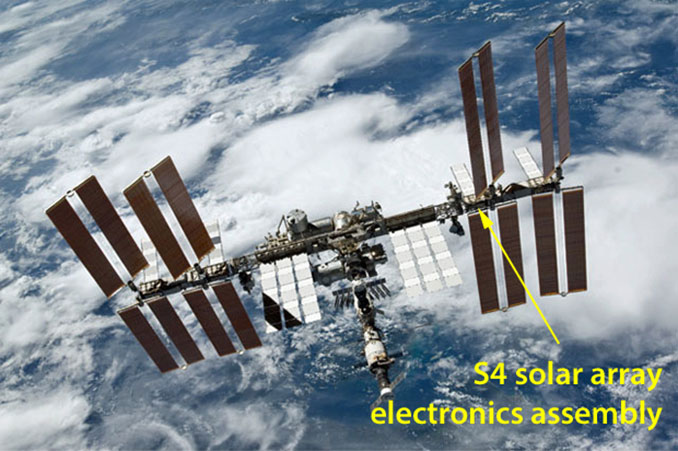STORY WRITTEN FOR CBS NEWS & USED WITH PERMISSION
Working over the New Year holiday weekend, robot arm operators at the Johnson Space Center will begin a complex procedure to replace 12 aging batteries in the International Space Station’s solar power system with six state-of-the-art lithium-ion power packs, a multi-step process over the next two weeks that will require two spacewalks to complete.
Without the remotely-controlled arm operations, it would take six spacewalks to carry out the battery swap out. But arm operators in Houston, starting New Year’s Eve, will swap out three batteries before Expedition 50 commander Shane Kimbrough and Peggy Whitson venture outside on Jan. 6 to continue the work.
After additional robot arm operations, Kimbrough and European Space Agency astronaut Thomas Pesquet will carry out a second spacewalk Jan. 13 before a final round of robot arm operations Jan. 14 and 15.
It is the most complex remotely controlled robot arm work yet implemented aboard the space station, an intricate, multi-step, multi-shift procedure that resembles a shell game of sorts, with old and new batteries moving to and fro between a cargo pallet, temporary mounting fixtures and a solar array electronics unit.
The space station is equipped with four huge sets of solar arrays that slowly rotate to track the sun as the laboratory circles the Earth. Each set of arrays powers two of the station’s eight electrical buses and each set of arrays is equipped with 12 nickel-hydrogen batteries to provide electricity when the lab is in Earth’s shadow.
Station assembly began in 1998 and the original-equipment batteries are losing strength. So, over the next few years, all 48 of the nickel-hydrogen batteries will be replaced with 24 smaller, more efficient lithium-ion batteries that will keep the station in good health through its remaining life.
The first set of six replacement batteries was carried to the station aboard a Japanese HTV cargo ship that reached the lab complex Dec. 13. Flight controllers in Houston used the station’s robot arm, equipped with a multi-appendage hand-like special purpose dexterous manipulator, or SPDM, to remove a pallet carrying the new batteries on Dec. 14.
The pallet then was maneuvered to the right side of the station’s power truss and temporarily mounted near the inboard starboard 4, or S4, set of arrays powering electrical channels 1A and 3A. The S4 arrays, and their batteries, were launched in June 2007.
Along with carrying the six new batteries to the station, the pallet will be used to carry nine of the 12 older batteries away from the station. They will burn up, along with the HTV, when the cargo ship re-enters the atmosphere after departing the station. Three of the older batteries will be left in storage aboard the lab.
Six adapter plates also were carried up on the HTV, three for electrical channel 1A and three for channel 3A. The adapter plates feature cables and circuitry to connect the new lithium-ion batteries to the station’s power grid. The three nickel-hydrogen batteries remaining on the station will be mounted atop three of the adapter plates.
Starting New Year’s Eve and continuing through Jan. 3, arm operators in Houston plan to begin the channel 3A work, moving three lithium-ion batteries from the HTV pallet to the integrated electronics assembly, or IEA, at the base of the S4 arrays. Three nickel-hydrogen batteries will be installed on the HTV pallet while a fourth will be temporarily mounted on a SPDM attachment fixture.
During U.S. EVA-38 on Jan. 6, Kimbrough and Whitson will complete the channel 3A swap-out, moving three adapter plates to the IEA and mounting two of the three nickel-hydrogen batteries that will remain in place atop those plates. Three lithium-ion batteries will already be in place thanks to earlier robotic arm operations.
Starting Jan. 8 and continuing through Jan. 12, arm operators will focus on channel 1A. Three nickel-hydrogen batteries in the electronics assembly will be moved to the HTV pallet and two more will be temporarily mounted on the SPDM. Three lithium-ion batteries will be moved from the pallet to the electronics assembly.
Kimbrough and Pesquet then will venture outside on Jan. 13, moving an adapter plate and one of the older batteries to the IEA. At this point, the three nickel-hydrogen batteries that will remain aboard the station will be in their designated positions. The astronauts will move two more adapter plates to the IEA.
Robot arm operators then will finish the battery replacement work on Jan. 14 and 15, moving the three nickel-hydrogen batteries mounted on the SPDM and a nearby attachment fitting to the HTV pallet. The pallet will be moved back to the HTV and mounted in its unpressurized cargo bay on Jan. 17. The HTV is scheduled to depart the station on Jan. 27.
With the battery replacement work out of the way, the station crew will focus on research as Kimbrough, Soyuz MS-02 commander Sergey Ryzhikov and flight engineer Sergey Borisenko wind up their stay in orbit before returning to Earth in late February.
Their replacements, Soyuz MS-04 commander Fyodor Yurchikhin and NASA flight engineer Jack Fischer, are expected to launch at the end of March.
The Russians have not yet revealed the results of an investigation to find out what triggered the loss of a Progress cargo ship Dec. 1 or what impact that might have on downstream flights.

